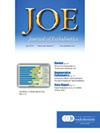Reinforcing Effect of Intraradicular Filling Materials in Simulated Immature Mandibular Premolars with Mineral Trioxide Aggregate Apical Barrier: A Weibull Analysis
IF 3.6
2区 医学
Q1 DENTISTRY, ORAL SURGERY & MEDICINE
引用次数: 0
Abstract
Introduction
Incomplete root formation following pulp necrosis requires mineral trioxide aggregate (MTA) apexification. Although effective, this treatment does not increase the root thickness, necessitating additional reinforcement. This study aimed to evaluate the fracture resistance of simulated immature mandibular premolars apexified with MTA and reinforced with various materials using Weibull analysis.
Methods
Ninety human mandibular first premolars were prepared to simulate immature teeth. After MTA apexification, teeth were divided into six groups: negative control (intact teeth), positive control (untreated apexified teeth), gutta-percha (GP) with AH Plus, GP with Bioceramic sealer, core, and fiber post/core. The teeth underwent thermocycling, periodontal ligament simulation, and fracture testing.
Results
Negative and positive controls exhibited the highest and lowest fracture resistance, respectively. Core and fiber post/core had hazard ratios of 4.79 and 6.23, respectively, outperforming GP with AH Plus and GP with Bioceramic sealer (hazard ratios: 14.23 and 17.22, respectively). Most fractures occurred in the coronal third.
Conclusions
Intraradicular reinforcement materials (fiber post/core and core) provided greater support to MTA-apexified roots than conventional root filling materials (GP/AH Plus and GP/Bioceramic sealer).
三氧化二矿骨料根尖屏障对模拟下颌前磨牙根内充填材料增强效果的Weibull分析。
髓质坏死后不完全的根形成需要矿物三氧化物骨料(MTA)尖化。虽然有效,但这种处理不会增加根的厚度,因此需要额外的加固。本研究采用Weibull分析方法评价MTA拔尖和不同材料加固的模拟未成熟下颌前磨牙的抗骨折性。方法:制备90颗人下颌第一前磨牙,模拟未成熟牙。MTA拔尖后的牙分为阴性对照组(完整牙)、阳性对照组(未经治疗的拔尖牙)、杜胶-percha (GP) + AH +、GP +生物陶瓷封口剂、牙芯和纤维桩/牙芯6组。牙齿进行热循环、牙周韧带模拟和断裂测试。结果:阴性对照和阳性对照分别表现出最高和最低的抗骨折能力。芯和纤维桩/芯的风险比分别为4.79和6.23,优于AH Plus GP和生物陶瓷GP(风险比分别为14.23和17.22)。大多数骨折发生在冠状三分之一。结论:根内增强材料(纤维桩/芯和芯)比传统的根填充材料(GP/AH Plus和GP/生物陶瓷密封剂)对mta根尖化根的支持更大。
本文章由计算机程序翻译,如有差异,请以英文原文为准。
求助全文
约1分钟内获得全文
求助全文
来源期刊

Journal of endodontics
医学-牙科与口腔外科
CiteScore
8.80
自引率
9.50%
发文量
224
审稿时长
42 days
期刊介绍:
The Journal of Endodontics, the official journal of the American Association of Endodontists, publishes scientific articles, case reports and comparison studies evaluating materials and methods of pulp conservation and endodontic treatment. Endodontists and general dentists can learn about new concepts in root canal treatment and the latest advances in techniques and instrumentation in the one journal that helps them keep pace with rapid changes in this field.
 求助内容:
求助内容: 应助结果提醒方式:
应助结果提醒方式:


